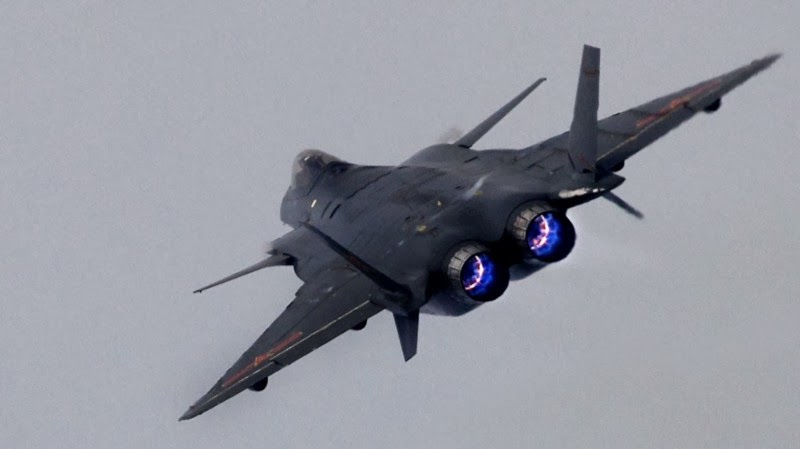Friday, January 31, 2014
Although some consider Chinese fighters to be little more than less impressive copies of Russian designs, the J-20, China's first fifth-generation stealth fighter, has the potential to become one of the world's most iconic military aircraft like Japan's Mitsubishi A6M Zero during World War II, according to Aireview, a Japanese magazine covering military aviation news.
Before the Zero first saw action against the Russian-built I-15bis and I-16 fighters operated by the Republic of China Air Force over Chongqing in September 1940, most Western military experts had a similar view of the Japanese fighter as people have towards Chinese fighters today, the magazine said.
Claire Lee Chennault, the legendary leader of the Flying Tigers — a group of American volunteer aviators recruited to help the ROC combat Japanese forces — sent warning to Washington about the threat posed by the Zero at the time, however none of his supervisors believed that Japan was able to effectively design its own plane.
The United States learned first-hand the now legendary capabilities of the Japanese fighter when Zeros wiped out the US defenses at Pearl Harbor and Manila in December 1941. The Zero's performance in the early stages of the Pacific War earned it a formidable reputation. Aireview said China is now developing an advanced fighter which may in time earn a similar reputation.
The article also said Chinese fighters are currently only superior in their numbers but not in quality, adding that without active electronically scanned array radar, China's J-10A fighter is unlikely to defeat Japan's American-built F-15J in a dogfight. The J-10B, the upgraded version of the J-10A, is reported to be equipped with active electronically scanned array radar but China does not have enough early warning aircraft compared to the United States and Japan, the magazine said.
Meanwhile, the Japan Air Self-Defense Force has 17 early warning aircraft and China has 11 — among them, only five are the most advanced Chinese KJ-2000 early warning planes. The People's Liberation Army Air Force and Navy Air Force have around 1,500 fighters, five times the number of Japan, however China would at present still not be able to win a decisive air battle against Japan. However, the article maintained that China will be able to fix these problems in the future.
The J-10B and its successor, the J-20, both have the potential to reach the level of fame as the Zero during World War II, the magazine said, if the Chinese aviation industry is capable of upgrading the aircraft's software. Aireview stated that the J-20, with a large fuselage, is likely to be designed as a long-range multi-role fighter which can also be used as a tactical bomber.
As for the J-31, China's second prototype stealth fighter, its main purpose is to be exported to developing nations which are not able to purchase the US-built F-35, the magazine added.
Before the Zero first saw action against the Russian-built I-15bis and I-16 fighters operated by the Republic of China Air Force over Chongqing in September 1940, most Western military experts had a similar view of the Japanese fighter as people have towards Chinese fighters today, the magazine said.
Claire Lee Chennault, the legendary leader of the Flying Tigers — a group of American volunteer aviators recruited to help the ROC combat Japanese forces — sent warning to Washington about the threat posed by the Zero at the time, however none of his supervisors believed that Japan was able to effectively design its own plane.
The United States learned first-hand the now legendary capabilities of the Japanese fighter when Zeros wiped out the US defenses at Pearl Harbor and Manila in December 1941. The Zero's performance in the early stages of the Pacific War earned it a formidable reputation. Aireview said China is now developing an advanced fighter which may in time earn a similar reputation.
The article also said Chinese fighters are currently only superior in their numbers but not in quality, adding that without active electronically scanned array radar, China's J-10A fighter is unlikely to defeat Japan's American-built F-15J in a dogfight. The J-10B, the upgraded version of the J-10A, is reported to be equipped with active electronically scanned array radar but China does not have enough early warning aircraft compared to the United States and Japan, the magazine said.
Meanwhile, the Japan Air Self-Defense Force has 17 early warning aircraft and China has 11 — among them, only five are the most advanced Chinese KJ-2000 early warning planes. The People's Liberation Army Air Force and Navy Air Force have around 1,500 fighters, five times the number of Japan, however China would at present still not be able to win a decisive air battle against Japan. However, the article maintained that China will be able to fix these problems in the future.
The J-10B and its successor, the J-20, both have the potential to reach the level of fame as the Zero during World War II, the magazine said, if the Chinese aviation industry is capable of upgrading the aircraft's software. Aireview stated that the J-20, with a large fuselage, is likely to be designed as a long-range multi-role fighter which can also be used as a tactical bomber.
As for the J-31, China's second prototype stealth fighter, its main purpose is to be exported to developing nations which are not able to purchase the US-built F-35, the magazine added.
Subscribe to:
Post Comments (Atom)








0 comments:
Post a Comment